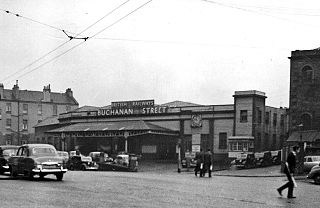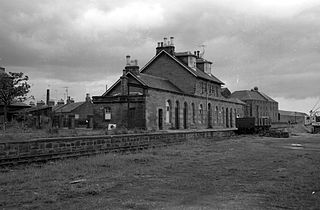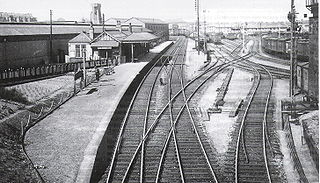Related Research Articles

The Caledonian Railway (CR) was a major Scottish railway company. It was formed in the early 19th century with the objective of forming a link between English railways and Glasgow. It progressively extended its network and reached Edinburgh and Aberdeen, with a dense network of branch lines in the area surrounding Glasgow. It was absorbed into the London, Midland and Scottish Railway in 1923. Many of its principal routes are still used, and the original main line between Carlisle and Glasgow is in use as part of the West Coast Main Line railway.

The Great North of Scotland Railway (GNSR) was one of the two smallest of the five major Scottish railway companies prior to the 1923 Grouping, operating in the north-east of the country. Formed in 1845, it carried its first passengers the 39 miles (63 km) from Kittybrewster, in Aberdeen, to Huntly on 20 September 1854. By 1867 it owned 226+1⁄4 route miles (364.1 km) of line and operated over a further 61 miles (98 km).

The Alford Valley Railway is a 2 ft narrow gauge railway in the Howe of Alford, Aberdeenshire, Scotland. It is located at what used to be the terminus of the passenger and goods Alford Valley Railway which connected with the Great North of Scotland Railway main line at Kintore.
The Maryport & Carlisle Railway (M&CR) was an English railway company formed in 1836 which built and operated a small but eventually highly profitable railway to connect Maryport and Carlisle in Cumberland, England. There were many small collieries in the area and efficient access to the harbour at Maryport was important.

Deansgate is a railway station in Manchester city centre, England, 1,100 yards (1 km) west of Manchester Piccadilly, close to Castlefield at the junction of Deansgate and Whitworth Street West. It is part of the Manchester station group.

Buchanan Street station is a former railway station in Glasgow. Less well known than the city's other terminus stations – Central, Queen Street and St Enoch – it was situated to the north-west of Queen Street station and served the north of Scotland.
The Scottish Central Railway was formed in 1845 to link Perth and Stirling to Central Scotland, by building a railway line to join the Edinburgh and Glasgow Railway near Castlecary.

The Aberdeen Railway was a Scottish railway company which built a line from Aberdeen to Forfar and Arbroath, partly by leasing and upgrading an existing railway.

The Deeside Railway was a passenger and goods railway between Aberdeen and Ballater in Aberdeenshire, Scotland. Opening in 1853 to Banchory, an extension reached Aboyne in 1859. A separate company, the Aboyne & Braemar Railway, built an extension to Ballater and this opened in 1866. By 1855 there were five services a day over the 43+1⁄4-mile (69.6 km) long line, taking between 1 hour 50 minutes and 2+1⁄2 hours. The line was used by the Royal Train for travel to and from Balmoral Castle from 1853 and a special 'Messenger Train' ran daily when the Royal Family was in residence.
The Perth and Dunkeld Railway was a Scottish railway company. It was built from a junction with the Scottish Midland Junction Railway at Stanley, north of Perth, to a terminus at Birnam, on the south bank of the River Tay opposite Dunkeld.
The Dundee and Arbroath Railway was an early railway in Scotland. It opened in 1838, and used the unusual track gauge of 5 ft 6 in (1,676 mm). In 1848 it changed to standard gauge and connected to the emerging Scottish railway network.
The Dundee and Perth Railway was a Scottish railway company. It opened its line in 1847 from Dundee to a temporary station at Barnhill and extended to Perth station in 1849. It hoped to link with other railways to reach Aberdeen and changed its name to the Dundee and Perth and Aberdeen Railway Junction Company, but this early attempt was frustrated, and for some years it failed to make a physical connection with other railways in Dundee.
The Edinburgh and Northern Railway was a railway company authorised in 1845 to connect Edinburgh to both Perth and Dundee. It relied on ferry crossings of the Firth of Forth and the Firth of Tay, but despite those disadvantages it proved extremely successful. It took over a short railway on the southern shore of the Forth giving a direct connection to Edinburgh, and it changed its name to the Edinburgh, Perth and Dundee Railway.
Aberdeen Ferryhill railway station was the temporary terminus of the Aberdeen Railway and the first railway station to serve the city of Aberdeen. Regular passenger service began on 1 April 1850. As the station is located some distance south of the city centre, omnibuses and luggage vans were employed to complete the journey into the city. In 1853, the Deeside Railway was opened, which also used Ferryhill as a terminus. In 1854, the railway was extended and a new terminus, Aberdeen Guild Street railway station, was opened on 2 August. This station was located closer to the city centre, approximately where the present-day Aberdeen railway station was later built.
Ingleton (Midland) railway station was one of two stations serving the village of Ingleton, North Yorkshire, England. It was originally open for just ten months between 1849 and 1850, and did not reopen until 1861. It then served as the frontier between the Midland Railway to the south and the London and North Western Railway to the North, with trains from each railway terminating at the station. Through trains did not begin until the two companies were merged in 1923. The station closed in 1954. The village's Community Centre is now on the site of the former station.

The Montrose and Bervie Railway was a Scottish railway. When the Aberdeen Railway opened in 1850, the coastal settlements north of Montrose were not linked in, and local interests promoted a branch line from Montrose to Bervie. They found it impossible to raise capital at first, but from 1861 the larger railways were promoting new connections around Aberdeen, and the Great North of Scotland Railway (GNoSR) decided that the Bervie line would give it a route to the south.

There have been three Kittybrewster railway stations at Kittybrewster, Aberdeen. The first opened in 1854 as a terminus of the Great North of Scotland Railway's (GNoSR) first line to Huntly. This was replaced two years later by a station on a new line to a city terminus at Waterloo. It was replaced again when the Denburn Valley Line to Aberdeen Joint opened in 1867.
Marykirk railway station served the village of Marykirk, Kincardineshire, Scotland from 1849 to 1956 on the Aberdeen Railway.
Barnhill railway station served the suburb of Barnhill, Perth and Kinross, Scotland, from 1847 to 1849 by the Dundee and Perth Railway.

The Dundee–Aberdeen line is a railway line linking Dundee and Aberdeen in Scotland.
References
- ↑ "Aberdeen Railway". Glasgow Herald. 9 November 1849. Retrieved 3 June 2020.
- ↑ "Opening of the Main Line to Limpet Mill". Arbroath Guide. 3 November 1849. p. 15. Retrieved 20 April 2022.
- ↑ Quick, M E (2002). Railway passenger stations in England, Scotland and Wales - a chronology. Richmond: Railway and Canal Historical Society. p. 252. OCLC 931112387.